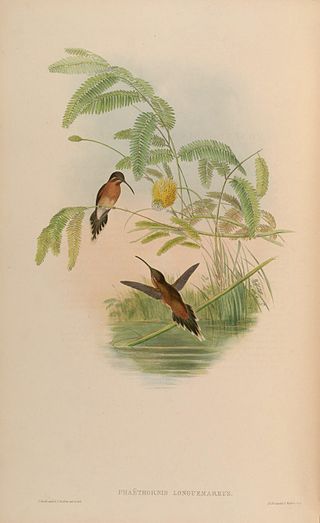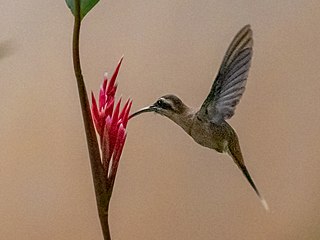
The green hermit is a large hummingbird that is a resident breeder from southern Central America south to northern South America

The little hermit is a hummingbird that is a resident breeder in north-eastern Venezuela, northern Guyana, Suriname, French Guiana and Trinidad. This lowland species occurs in various semi-open wooded habitats, e.g. mangrove, secondary forest, plantations and scrub. In Trinidad it also occurs in rainforest. It is fairly common in most of its range, and therefore listed as Least Concern by BirdLife International on the IUCN Red List.

The buff-throated woodcreeper is a species of bird in the subfamily Dendrocolaptinae of the ovenbird family Furnariidae. It is found in Bolivia, Brazil, Colombia, Ecuador, French Guiana, Guyana, Peru, Suriname, and Venezuela.

The hermits are tropical and subtropical hummingbirds in the subfamily Phaethornithinae, comprising 37 species in six genera. They occur from southern Mexico, through Central America, to South America as far south as northern Argentina.

Phaethornis is a genus of hummingbirds in the hermit subfamily, Phaethornithinae. They occur from southern Mexico, through Central America, to South America as far south as northern Argentina.

The long-billed hermit is a bird in the family Trochilidae, the hummingbirds. It is found from central Mexico south through Central America, Colombia and Ecuador into Peru.

The long-tailed hermit is a large hummingbird that is a resident breeder in Venezuela, the Guianas, and north-eastern Brazil. This species was formerly referred to as the eastern long-tailed hermit.

The wedge-billed woodcreeper is a sub-oscine passerine bird in subfamily Dendrocolaptinae of the ovenbird family Furnariidae. It is found in Mexico, Central America, Brazil, Bolivia, Ecuador, French Guiana, Guyana, Peru, Suriname, and Venezuela.

The bronzy hermit is a species of hummingbird in the family Trochilidae. It is found in Colombia, Costa Rica, Ecuador, Honduras, Nicaragua, and Panama.

The tawny-bellied hermit is a species of hummingbird in the family Trochilidae. It is found in Colombia, Ecuador, and Peru.

The pale-bellied hermit is a species of hummingbird in the family Trochilidae. It is found in Colombia, Panama, and Venezuela.

The black-throated hermit is a species of hummingbird in the family Trochilidae. It is found in Colombia, Ecuador, and Peru.

The grey-chinned hermit is a species of hummingbird in the family Trochilidae. It is found in Brazil, Colombia, Ecuador, Peru, and Venezuela.

Koepcke's hermit is a species of hummingbird in the family Trochilidae. It is endemic to Peru.

The cinnamon-throated hermit is a species in the hummingbird family Trochilidae. It is found in Bolivia and Brazil.

The reddish hermit is a species of bird in the family Trochilidae, the hummingbirds. It is found in Bolivia, Brazil, Colombia, Ecuador, Peru, Venezuela, and the Guianas.

The streak-throated hermit, also known as the Rupurumi hermit, is a species of hummingbird in the family Trochilidae. It is found in Brazil, Colombia, Guyana, and Venezuela.

The rufous-breasted piculet is a species of bird in subfamily Picumninae of the woodpecker family Picidae. It is found in Bolivia, Brazil, Colombia, Ecuador, and Peru.

The Tapajós hermit is a species of hummingbird in the family Trochilidae. It is endemic to Brazil.

The Mexican hermit is a species of hummingbird in the family Trochilidae. It is endemic to Mexico.























